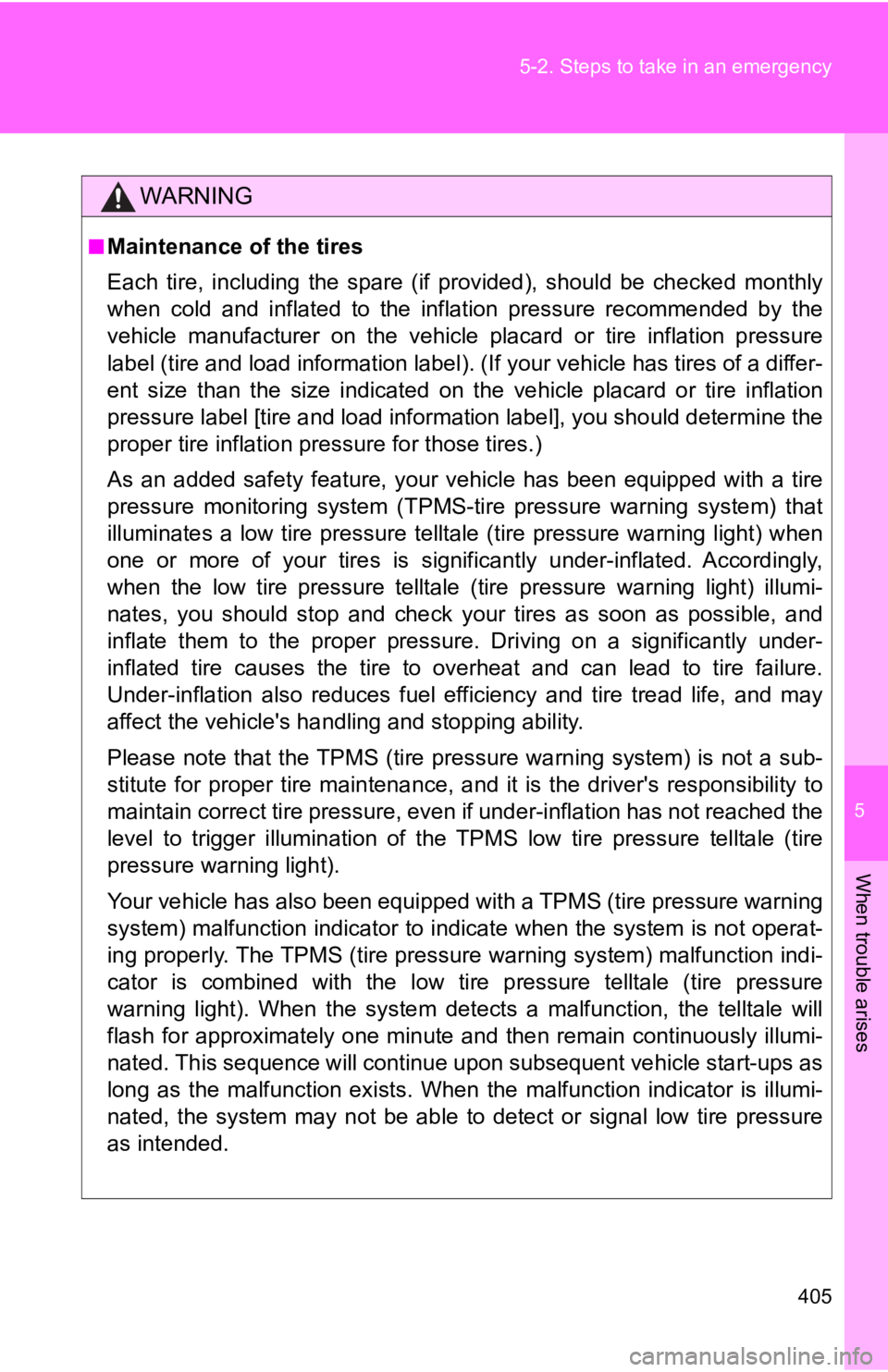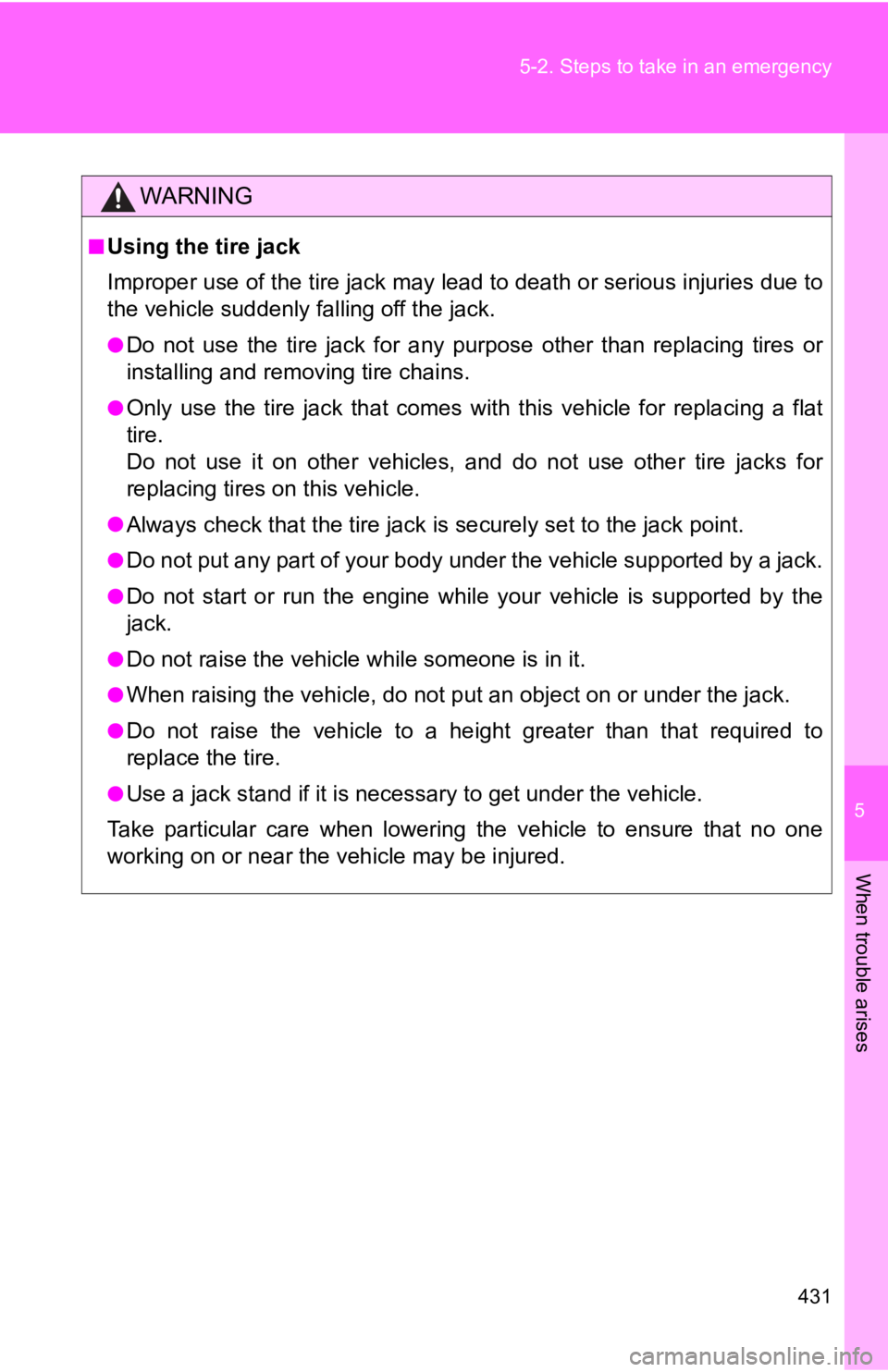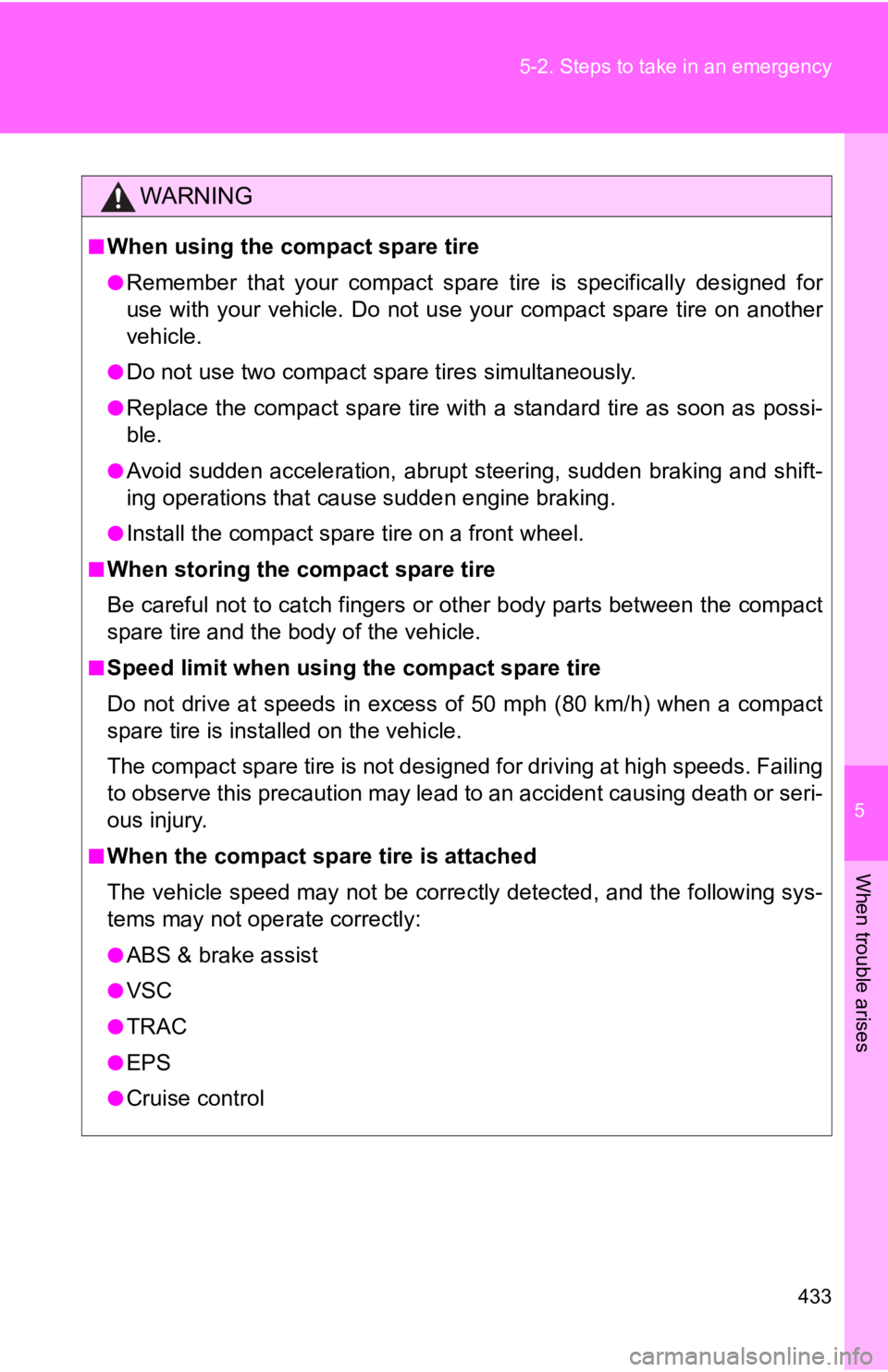Page 393 of 532

5
When trouble arises
3935-1. Essential information
If you think something is wrong If you notice any of the followi ng symptoms, your vehicle proba bly
needs adjustment or repair. Cont act your Toyota d ealer as soon as
possible.
■ Visible symptoms
● Fluid leaks under the vehicle
(Water dripping from t he air conditioning after use is normal.)
● Flat-looking tires or uneven tire wear
● Vehicles with a monochrome multi-information display: The
engine coolant temperature gauge needle continually points
higher than normal
● Vehicles with a color multi-information display: The high
engine coolant temperature wa rning light flashes or illumi-
nates
■ Audible symptoms
● Changes in exhaust sound
● Excessive tire squeal when cornering
● Strange noises related to the suspension system
● Pinging or other noises related to the engine
■ Operational symptoms
● Engine missing, stumbling or running rough
● Appreciable loss of power
● Vehicle pulls heavily to one side when braking
● Vehicle pulls heavily to one side when driving on a level road
● Loss of brake effectiveness, s pongy feeling, pedal almost
touches the floor
Page 403 of 532

5
When trouble arises
4035-2. Steps to take in an emergency
■
If the tire pressure warn ing system is inoperative
The tire pressure warning system will be disabled in the follow ing condi-
tions:
(When the condit ion becomes no rmal, the system will work proper ly.)●
If tires not equipped with tire pressure warning valves and tra nsmit-
ters are used.●
If the ID code on the tire pressure warning valves and transmit ters is
not registered in the tire pressure warning computer.●
If the tire inflation p ressure is 55 psi ( 380 kPa, 3.87 kgf/cm 2
or bar) or
higher.
The tire pressure warning system may be disabled in the followi ng condi-
tions:
(When the condit ion becomes no rmal, the system will work proper ly.)●
If electronic devices or facilities using similar radio wave fr equencies
are nearby.●
If a radio set at similar frequen cies is in use i n the vehicle.●
If a window tint that affects the radio wave signals is install ed.●
If there is a lot of snow or ice on the vehicle, in particular around the
wheels or wheel housings.
●
If non-genuine Toyota wheels are used. (Even if you use Toyota
wheels, the tire pressure warning system may not work properly with
some types of tires.)
●
If tire chains are used.
●
If a large metallic object which can interfere with signal rece ption is
put in the trunk.
■
If the tire pressure warning light frequently comes on after bl inking
for approximately one minute
If the tire pressure warning light frequently comes on after bl inking for
approximately one minute when the “ENGINE START STOP” switch is
turned to IGNITION ON mode (vehicles with a smart key system) o r the
engine switch is turned to the “ON” position (vehicles without a smart key
system), have it check ed your Toyota dealer.
Page 404 of 532
4045-2. Steps to take in an emergency
WARNING■
If the tire pressure wa rning light comes on
Be sure to observe the following precautions. Failure to do so could
cause loss of vehicle control and result in death or serious in jury.●
Stop your vehicle in a safe plac e as soon as possible. Adjust t he tire
inflation pressure immediately.●
If the tire pressure warning light comes on even after tire inf lation pres-
sure adjustment, it is probable that you have a flat tire. Chec k the tires.
If the tire is flat, change to the spare tire and have the flat tire repaired
by the nearest Toyota dealer.●
Avoid abrupt maneuvering and braking. If the vehicle tires dete riorate,
you could lose control of the s teering wheel or the brakes.■
If a blowout or sudden air leakage should occur
The tire pressure warning system may not activate immediately.
Page 405 of 532

5
When trouble arises
4055-2. Steps to take in an emergency
WARNING■
Maintenance of the tires
Each tire, including the spare (if provided), should be checked monthly
when cold and inflated to the inflation pressure recommended by the
vehicle manufacturer on the vehicle placard or tire inflation p ressure
label (tire and load information label). (If your vehicle has t ires of a differ-
ent size than the size indicated on the vehicle placard or tire inflation
pressure label [tire and load information label], you should de termine the
proper tire inflation pressure for those tires.)
As an added safety feature, your vehicle has been equipped with a tire
pressure monitoring system (TPMS -tire pressure warning system) that
illuminates a low tire pressure telltale (tire pressure warning light) when
one or more of your tires is significantly under-inflated. Acco rdingly,
when the low tire pressure telltale (tire pressure warning ligh t) illumi-
nates, you should stop and check your tires as soon as possible , and
inflate them to the proper press ure. Driving on a significantly under-
inflated tire causes the tire to overheat and can lead to tire failure.
Under-inflation also reduces fuel efficiency and tire tread lif e, and may
affect the vehicle's han dling and stopping ability.
Please note that the TPMS (tire pressure warning system) is not a sub-
stitute for proper tire maintenance, and it is the driver's res ponsibility to
maintain correct tire pressure, even if under-inflation has not reached the
level to trigger illumination of the TPMS low tire pressure tel ltale (tire
pressure warning light).
Your vehicle has also been equipped with a TPMS (tire pressure warning
system) malfunction indicator to indicate when the system is no t operat-
ing properly. The TPMS (tire pressure warning system) malfuncti on indi-
cator is combined with the low tire pressure telltale (tire pre ssure
warning light). When the system detects a malfunction, the tell tale will
flash for approximately one minut e and then remain continuously illumi-
nated. This sequence will continue upon subsequent vehicle star t-ups as
long as the malfunction exists. When the malfunction indicator is illumi-
nated, the system may not be able to detect or signal low tire pressure
as intended.
Page 406 of 532
4065-2. Steps to take in an emergency
WARNINGTPMS (tire pressure warning system) malfunctions may occur for a vari-
ety of reasons, including the installation of replacement or al ternate tires
or wheels on the vehicle that prevent the TPMS (tire pressure w arning
system) from functioning properl y. Always check the TPMS (tire pres-
sure warning system) malfunctio n telltale after replacing one o r more
tires or wheels on your vehicle to ensure that the replacement or alter-
nate tires and wheels allow the TPMS (tire pressure warning sys tem) to
continue to function properly.
NOTICE■
To ensure the tire pressure warning system operates properly
Do not install tires with different specifications or makers, as the tire
pressure warning system may not operate properly.
Page 426 of 532
4265-2. Steps to take in an emergency
Replacing a flat tire
Chock the tires.
Slightly loosen the wheel nuts
(one turn).STEP 1
Flat tire Wheel
chock posi-
tions
Front Left-
hand
side Behind the
rear right-
hand side
tire
Right-
hand
side Behind the
rear left-
hand side
tire
Rear Left-
hand
side In front of
the front
right-hand
side tire
Right-
hand
side In front of
the front
left-hand
side tireSTEP 2
Page 431 of 532

5
When trouble arises
4315-2. Steps to take in an emergency
WARNING■
Using the tire jack
Improper use of the tire jack may lead to death or serious inju ries due to
the vehicle suddenly falling off the jack. ●
Do not use the tire jack for any purpose other than replacing t ires or
installing and removing tire chains.●
Only use the tire jack that comes with this vehicle for replacing a flat
tire.
Do not use it on other vehicles, and do not use other tire jack s for
replacing tires on this vehicle.●
Always check that the tire jack is securely set to the jack poi nt.●
Do not put any part of your body under the vehicle supported by a jack.●
Do not start or run the engine while your vehicle is supported by the
jack.
●
Do not raise the vehicle while someone is in it.
●
When raising the vehicle, do not put an object on or under the jack.
●
Do not raise the vehicle to a height greater than that required to
replace the tire.
●
Use a jack stand if it is necessary to get under the vehicle.
Take particular care when lowering the vehicle to ensure that n o one
working on or near the vehicle may be injured.
Page 433 of 532

5
When trouble arises
4335-2. Steps to take in an emergency
WARNING■
When using the compact spare tire ●
Remember that your compact spare tire is specifically designed for
use with your vehicle. Do not use your compact spare tire on an other
vehicle.●
Do not use two compact spa re tires simultaneously.●
Replace the compact spare tire with a standard tire as soon as possi-
ble.●
Avoid sudden acceleration, abrupt steering, sudden braking and shift-
ing operations that cause sudden engine braking.●
Install the compact spar e tire on a front wheel. ■
When storing the compact spare tire
Be careful not to catch fingers or other body parts between the compact
spare tire and the body of the vehicle.
■
Speed limit when using the compact spare tire
Do not drive at speeds in excess of 50 mph (80 km/h) when a compact
spare tire is insta lled on the vehicle.
The compact spare tire is not designed for driving at high spee ds. Failing
to observe this precaution may lead to an accident causing deat h or seri-
ous injury.
■
When the compact spare tire is attached
The vehicle speed may not be corr ectly detected, and the follow ing sys-
tems may not ope rate correctly:
●
ABS & brake assist
●
VSC
●
TRAC
●
EPS
●
Cruise control